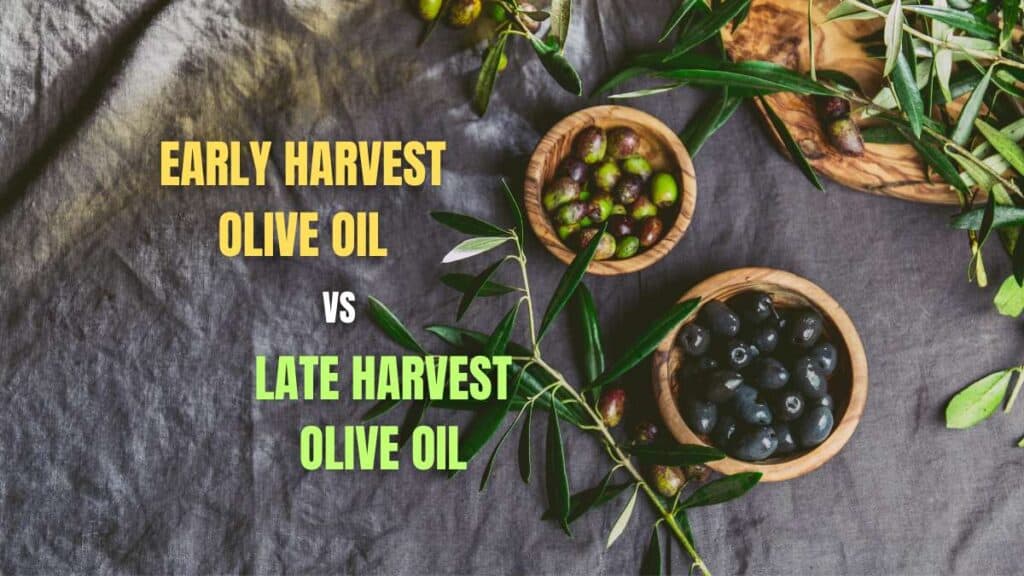Early Harvest vs. Late Harvest Olive Oil: Which One Is Better?
Olive Knowledge is a part of Amazon Associates. As an Amazon Associate, we earn from qualifying purchases. Read our Affiliate Disclosure to learn more.
When I moved to Dubrovnik, one local guy told me that he only produces olive oil from fully ripened olives (late harvest olive oil) because of all the health benefits. I thought that was completely true until I finally learned more about olives, olive trees, and olive oil.
In this post, I’ll show you the key differences between early harvest and late harvest olive oil, and which one you should get.
Key Takeaways:
- Early harvest olive oil is made from unripe olives, typically yielding higher quality but less oil.
- Characteristics include mostly extra virgin, greenish color, intense taste, and high in polyphenols.
- Late harvest olive oil comes from fully ripened olives, producing more oil with different properties.
- It often has a golden color, less bitterness, more floral flavors, and fewer polyphenols.
- While not inferior, late harvest oils generally have fewer benefits than early harvest oils.
What Is Early Harvest Olive Oil?

Early harvest olive oil (a.k.a. first harvest olive oil) is the type of olive oil made from olive fruits that didn’t have time to ripen fully. The best extra virgin olive oils (EVOO) are made from early-harvested olives and from the first press only.
In most countries, early harvesting occurs anywhere between mid-October to mid-November, depending on the year and overall climate conditions in that area. In these months, fruit isn’t fully ripened, with most fruits being green in color.
While olives are still unripe, they have specific properties that help olive growers make high-quality olive oils. Let’s look at the characteristics of first harvest olive oils.
Characteristics of Early Harvest Olive Oil
Early harvested olives won’t yield as much oil as late harvested olives. And that’s the most important reason premium olive oils are more expensive – the yield is low.
Early Harvest Olive Oil Characteristics:
- It’s mostly EVOO.
- The best quality olive oils.
- Most early harvest olive oils are made using cold press methods of extraction.
- More greenish color with a more intense smell and taste (bittery, which tastes like fresh grass, fruits, vegetables, and flowers).
- Greater olive oil health benefits (high in polyphenols and antioxidants).
For instance, the standard polyphenol content for extra virgin olive oil is 55mg/kg, and early harvested olive oils easily have more than 400mg/kg. More polyphenols = better oil. Now you know that not all extra virgin olive oils are the same.
As you can see, there are many great characteristics of olive oils made from early harvested olive fruits. Now, let’s see what late harvest olive oils are like.
What Is Late Harvest Olive Oil?

Late harvest olive oil is the type of olive oil made from fruit that has more time to ripen fully. More ripened olives have higher oil yield, thus producing more olive oil from 1kg of olives.
Late harvests usually happen anywhere between late November to even February. The later the harvest occurs, the more ripened the fruit will be. As I already said above, fruit that has more time to ripen will allow you to produce higher amounts of olive oil. But is it any good?
As long as olive oils are made from healthy fruits (potentially made in an organic way), they’re not bad – there are just better and worse olive oils. However, most low-quality olive oils are made from late harvests.
Characteristics of Late Harvest Olive Oil
Since it’s made from olive fruit that had more time to ripen fully, it’s expected that late harvest olive oils have different characteristics.
Late Harvest Olive Oil Characteristics:
- Usually not extra-virgin olive oils
- Little bitterness, golden color
- More floral flavors (peach, melon, perfumy, banana, etc.)
- Contains fewer polyphenols and antioxidants
- More acidity (usually)
Late harvest olive oils are usually cheaper to buy in shops, and that’s because olive growers were able to produce much more oil per 1kg of fruit, and the extracting (pressing) process isn’t so strict as with early harvested fruit. They’ll often press olives more than once to get more olive oil.
Which One Is Better?

I think you already know the answer if you read everything above. There’s not much to think about.
Early harvest olive oils are usually much better quality, and if your budget allows you, I always suggest buying early harvest olive extra virgin olive oil.
Of course, extra-virgin olive oils can be made from late harvested olives, no question about that. However, there are significant differences in EVOOs made from fruit harvested in November and the ones made from fruit harvested in February.
I don’t want you to think that late harvest olive oils are bad; they’re not. They just don’t have as many benefits as early harvest oils. There’s also a difference in taste based on the harvest time.
What Do Olive Growers Say?
When you talk to olive growers, you might get slightly different answers. At least that’s what I used to get when I was a complete newb in the olive oil world.
Here’s one claim I’ve got from a very old man who produced olive oil for 30+ years:
“My standard olive oil is much better than extra virgin olive oils. My olives had enough time to ripen, making them healthier.”
Of course, I bought the oil from him. And I can’t complain. The taste and everything else was fine, but later on, I learned that he didn’t tell the complete truth. The truth is that olive oils made from early harvested olives are much better because olives are healthier when not fully ripened. That’s why I always harvest olives when the olive maturity index is between 2.5 and 3.0.
Small olive growers who don’t have the money to invest in oil production will sometimes produce late-harvest olive oil just to get more of it.
On the other hand, large and serious olive growers aim to produce early-harvest olive oil. Even though they’ll get less oil yield, the price of olive oil will be higher. But to successfully sell expensive oils, you need good marketing, you have to go to various competitions, etc. And not everyone’s able to do that.
